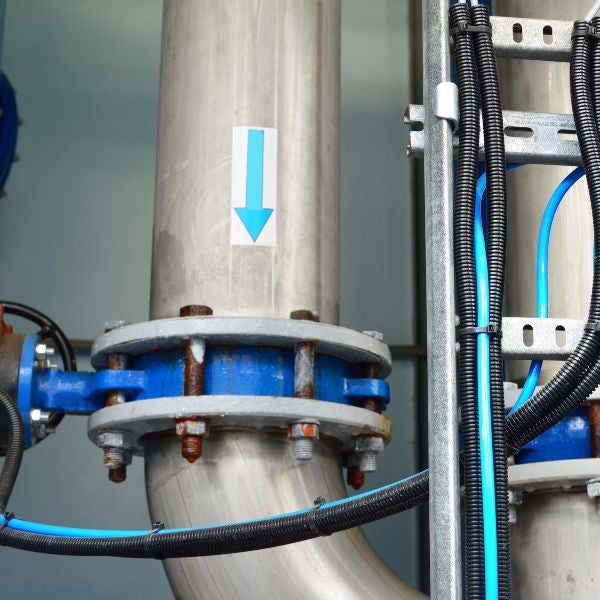Types of Backflow Preventers
The one-way flow of water into your home ensures you receive clean water for drinking, cooking, and bathing. However, sometimes the flow reverses, allowing contaminated water to mix with your clean supply. This plumbing anomaly is called backflow, and it occurs when water reverses its course, potentially introducing contaminants into the potable water system. The primary causes of backflow are backsiphonage and backpressure.
Backsiphonage occurs from a drop in water pressure, such as during a water main break or when a fire hydrant gets hit. This pressure drop can pull contaminants from areas like gardens or commercial locations into the drinking water.
Backpressure results from increased downstream water pressure. This can happen if an irrigation system gets blocked, causing contaminated water to push back into the clean supply.

What is Backflow Testing?
To stop backsiphonage and backpressure, you need backflow preventers, essential devices that maintain the integrity of your household’s water supply. Backflow prevention involves installing the right devices and ensuring they work effectively. That’s where backflow preventer testing comes in.
Evaluating the backflow prevention devices within your plumbing system allows certified plumbers to determine if these barriers are working optimally to protect your water. This regular assessment involves checking valves for leakage or malfunctions. If any issues arise, a quick, efficient repair ensures your water remains uncontaminated.
Importance of Backflow Testing
The consequences of backflow can be dire. Here’s what backflow testing aims to prevent:
- Disease: Backflow often involves sewage backups, introducing harmful bacteria to your water supply. This can lead to dysentery, typhoid, and salmonella outbreaks.
- Heavy metal contamination: Public spaces can experience heavy metal contamination due to backflow. Examples include copper poisoning from soda dispensers or other harmful metals leaching into the water system.
- Chemical contamination: Insecticides, herbicides, and other chemical waste products can enter the plumbing system through backflow, posing significant health hazards if consumed.
Varieties of Backflow Preventers
Different situations call for different types of backflow prevention devices. Some common ones include:
- Air gap (AG): This method separates potable and non-potable systems with a physical air space. The simplest example is the space between a faucet and a sink. Air gaps ensure contaminated water doesn’t mix with the clean water supply.
- Atmospheric vacuum breaker assembly (AVB): This device contains an air inlet valve and a check seat. When water flows, the air inlet valve closes. In the absence of water flow, the valve drops against the check seat, preventing back siphonage and allowing air intake.
- Pressure vacuum breaker assembly (PVB): Though similar to AVB, this device contains a spring-loaded air inlet valve and check valve, along with two shut-offs and test ports. It operates by ensuring the check valve remains open during water flow while the air inlet valve remains shut. When water stops, the roles reverse. PVB assemblies protect against back siphonage only—they are still vulnerable to backpressure.
- Spill-resistant vacuum breaker assembly (SVBs): While standard PVBs can occasionally leak water, SVBs offer a more secure solution, especially for indoor plumbing. Designed similarly to PVBs, SVBs incorporate extra diaphragm seals, ensuring water doesn’t escape from the air inlet during pressurization. Like PVBs, they safeguard against back siphonage but not backpressure.
- Double check valve assembly (DCVA): This device houses two spring-loaded check valves, two shut-off valves, and four test cocks. Dual check valves ensure a built-in backup if one fails.
- Reduced pressure principle backflow assembly (RP): Also known as a reduced pressure zone assembly, this system contains two spring-loaded check valves with a differential relief valve between them, two shut-off valves, and four test cocks. The relief valve maintains a reduced pressure zone and air gap between the check valves.
How to Choose the Right Type of Backflow Preventer
If you’re considering backflow prevention for your home or business, remember the following:
- Range of coverage: PVBs and similar assemblies aren’t equipped to handle backpressure or perform optimally in high-hazard situations, but they’re often adequate for household settings. In contrast, a higher level of protection is required for environments like hospitals and factories.
- Cost considerations: Prices for backflow preventers vary widely based on complexity, size, and the specific type of device. When comparing assemblies, the PVB is one of the more budget-friendly options. In contrast, the high-performing RP comes with a heftier price tag.
- Installation and maintenance complexity: Simple options like the PVB or SVB offer straightforward installation and maintenance procedures. On the other hand, the RP demands a more intricate installation process and advanced maintenance due to its comprehensive features. The DCVA’s installation and upkeep requirements fall between those of the PVB and RP.
Why Choose Us?
With 70 years of experience as a Florida State Certified company, Eagerton Plumbing proudly offers affordable, customized solutions to fit your unique needs. And when emergencies strike, we’re here for you 24 hours a day. To schedule backflow preventer testing or other plumbing services in Jacksonville, Orange Park, and the surrounding areas, please contact us at (904) 388-0761.
RECENT POSTS
categories
- Uncategorized
- Water Heater Installation
- Tankless Water Heater
- Plumbing Services
- Bathroom Remodeling
- Hot Water Heater
- Plumber in Jacksonville
- Water Heater Repair
- Eagerton Plumbing
- Eco-Friendly Plumbing Repair
- Water Damage
- Plumbing Leak
- Sewer Line Repair
- Infographic
- Clogged Drains
- Kitchen and Bathroom Remodel
- Bathroom Plumbing
- Residential Plumbing Services
- Garbage Disposal
- Toilet Repair
- Water Heater Replacement
- Water Conservation
- Emergency Plumbing
- Commercial Plumbing Services
- Kitchen Design Inspiration
- Kitchen Remodel
- low-flow toilets
- Leaky Faucet
- Conserve Water
- Drain Pipes
- Kitchen Sinks
- Vessel Sink
- Plumbing Problems
- Water Leak
- Commercial Remodeling Contractors
- Drain Cleaning Services
